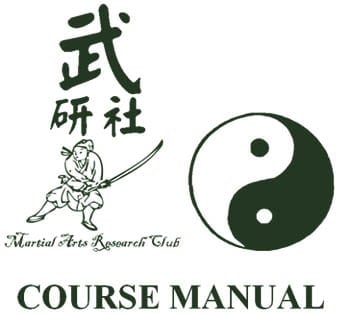
Contents
- Brief Introduction of Tai-Chi Quan
- 5 Basics Training in Cheng Man Ching Tai-Chi
- 37 Form Cheng Man Ching Tai-Chi
- Posture and Body Mechanics
- Practice with your Partner
- Q & A
- Web Source
A. Brief Introduction of Tai-Chi Quan
 The term Tai-Chi Quan translates as “supreme ultimate fist”, “boundless fist”, “great extremes boxing”, or simply “the ultimate”. The concept of the Taiji (“supreme ultimate”) appears in both Taoist and Confucian Chinese philosophy, where it represents the fusion or mother of Yin and Yang into a single Ultimate, represented by the Taijitu symbol.
The term Tai-Chi Quan translates as “supreme ultimate fist”, “boundless fist”, “great extremes boxing”, or simply “the ultimate”. The concept of the Taiji (“supreme ultimate”) appears in both Taoist and Confucian Chinese philosophy, where it represents the fusion or mother of Yin and Yang into a single Ultimate, represented by the Taijitu symbol.
Thus, tai chi theory and practice evolved in agreement with many Chinese philosophical principles, including those of Taoism and Confucianism.
While the image of tai chi chuan in popular culture is typified by exceedingly slow movement, many tai chi styles (including the three most popular – Yang, Wu, and Chen) – have secondary forms of a faster pace. Some traditional schools of tai chi teach partner exercises known as “pushing hands”, and martial applications of the forms’ postures.
In China, Tai chi quan is categorized under the Wudang grouping of Chinese martial arts—that is, the arts applied with internal power. Although the Wudang name falsely leads people to believe these arts originated at the so-called Wudang Mountain, as some of them did, it is simply a dichotomization to distinguish the skills, theories and applications of the “internal arts” from those of the Shaolin grouping, the “hard” or “external” martial art styles.
Since the first widespread promotion of tai chi’s health benefits by Yang Shaohou, Yang Chengfu, Wu Chien-ch’uan, and Sun Lutang in the early 20th century, it has developed a worldwide following among people with little or no interest in martial training, for its benefit to health and health maintenance. Medical studies of tai chi support its effectiveness as an alternative exercise and a form of martial arts therapy.
It is purported that focusing the mind solely on the movements of the form helps to bring about a state of mental calm and clarity. Besides general health benefits and stress management attributed to tai chi training, aspects of traditional Chinese medicine are taught to advanced tai chi students in some traditional schools.
The physical techniques of tai chi quan are described in the tai chi classics, a set of writings by traditional masters, as being characterized by the use of leverage through the joints based on coordination and relaxation, rather than muscular tension, in order to neutralize or initiate attacks. The slow, repetitive work involved in the process of learning how that leverage is generated gently and measurably increases, opens the internal circulation (breath, body heat, blood, lymph, peristalsis, etc.)
B. Basic Movements before the Form:
The Cheng Man Ching Tai-Chi is originally evolved from Yang Style, and there are five extra movements for basic training to loosen up and relax the body for the practice. Repeat each one with 2 to 5 minutes and maintain the squatting position according to your capability.
1. Arm swing with hip rotation:
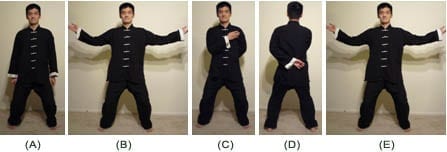
- Squat with your knees over the toes, back straight, shoulder relaxed.
- Raise up the arms from the side with elbows lower than the shoulder and palm up.
- Drop the arms and swing with on in front and one in the back. Mildly rotate your hip but keep knees over the toes.
- Swing back to the previous position and switch side.
2. Arm swing with squatting down and up:
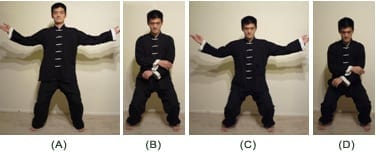
- Raise up the arms from the side with elbows lower than the shoulder and palm up.
- Swing the arm down and squat at the same time.
- Follow the sequence and squat down to your extreme when keeping the back straight.
- Reverse the sequence and stand up.
3. Hip rotation with hand tapping:
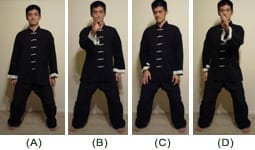
- Squat with your knees over the toes, back straight, shoulder relaxed.
- Raise up the arms from the side with elbows lower than the shoulder and palm up.
- Drop the arms and swing with on in front and one in the back. Mildly rotate your hip but keep knees over the toes.
- Swing back to the previous position and switch side.
4. Back stretching:
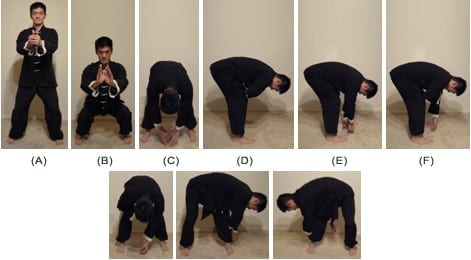
- (1) After deep breathing exercise, squat as low as you can and then straighten the legs while maintaining straight back (as possible).
- There are three parts of the back stretching: first is the arm dropping in the bending forward position. Do this as if you are picking up something from the floor and drop it.
- The second one is the arm circle. Make it from big to small and then just shake your trunk.
- The last one is rotating to the side.
- Finish them and resume the squatting position and stand up slowly.
5. Weight shifting:
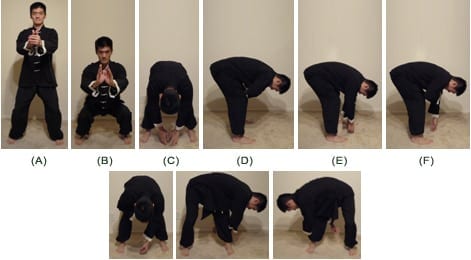
- The weight shifting is VERY important in Tai-Chi and there are two parts of this weight shifting exercise.
- Squat on the left leg and shift majority of your weight to the left foot while keeping the right leg straight.
- Transfer all the weight to your right foot while maintaining the trunk upright as if you are sitting on the chair. Repeat with the other side.
- The second part is sliding your non-weight bearing foot on the floor back and forth while keeping straight upright trunk as if sitting on a chair.
C. 37 form Cheng Man Ching Tai-Chi
| 1. Beginning of Tai-Chi
2. Part the Wild Horse’s Mane 3. Grasp Sparrow’s Tail 4. Single whip 5. Raise up hands, right 6. Strike with the Shoulder 7. White Crane Spreads Its Wings 8. Brush Knee and Twist Step, Left 9. Playing the Lute 10. Deflect, Parry, and Punch 11. Withdraw and Push, as if Closing a Door 12. Cross hands 13. Grasp Sparrow’s Tail 14. Single Whip 15. Behold the punch below the elbow 16. Step Back and Drive Monkey Away 17. Turn with slanted flying 18. Wave Hands Like Clouds |
19. Wave Hands Like Clouds, right20. Wave Hands Like Clouds, left
21. Single whip, lower position 22. Golden Rooster Stands on One Leg, right 23. Golden Rooster Stands on One Leg, left 24. Right kick 25. Left kick 26. Turn body and kick with heel 27. Step forward and punch down 28. Shuttle back and forth 29. Grasp Sparrow’s Tail 30. Single Whip, lower position 31. Step forward and cross hands 32. Turn body and swing kick 35. Deflect, Parry, and Punch 36. Withdraw and Push, as if Closing a Door 37. Closing |

